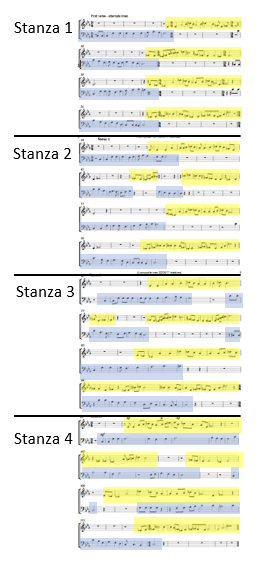“A conversation between two people who aren’t really listening to each other”
To find out the background to this piece, read Graham’s post about writing this poem – Not knowing… (part 2). I pick up straight up where Graham stops – with the finished poem winging its way over to me.
When Graham sent me his first version of this poem, it was clear the two conversations needed to be two separate entities, yet presented as one overall picture of the scene. I could already tell that the two characters- the (dead) coprolite digger and his wife – needed separate musical identities and songs, and had the idea that their singing should be entwined for the final stanza of the piece. Graham’s final presentation of the two monologues – a modern composite of two conversations- furthered my original thoughts.
If the two characters are ignoring each other, they must therefore be talking about separate things – having two conversation which occasionally collide. As a result, I decided to write a separate song for each character which would begin as separate entities, but overlap more as the piece progressed, eventually being presented almost simultaneously.
The first voice is that of a dead coprolite digger- which Graham has based around the skeleton of a folk song. Wanting to work along similar lines, my setting of this is centred around a folk or work song. It’s quite a simple melody, in three, catchy with a strong down beat. In contrast, the wife’s song is more lyrical, in a completely different tonality and has four beats in the bar. Choosing the tonalities for the two different songs was tricky. I deliberately picked tonalities that suited each, but was mindful of making sure they’d have elements of both dissonance and harmony. The three in a bar folk song is in C minor, while the soprano’s melody drifts between E flat minor and E flat locrian. This combination creates plenty of room for dissonance, but yet space for moments of harmony too. Think of it as one vocalist singing Twinkle Twinkle (major) while the other sings Teddy Bear’s Picnic (minor) a few notes lower – and adds in some colourful extra accidentals!
Below is a rough diagram of how the voices are sliding over each other (and combining!) at the moment – at the stage where I’m tidying up the first draft of the piece. As you can see, for the first stanza the voices only momentarily overlap at the end of each phrase. The moments of overlap (or alternating phrases) increase in the second stanza, bar one line. They increase further as the piece progresses, until they’re almost completely entwined in stanza four – save for the last line, where each can be heard independently again – each saying their piece to end the conversation.

Of course, this method of creating a piece brings further questions with it. How do you ensure each part is heard fully (or do you abandon that entirely?). What time signature(s) and key signatures(s) do you use, and how do you ensure the vocalists maintain the original feel of their songs when they’re being pushed and pulled around a bit time and tempo wise? All good questions – all of which I need to answer as I finish drafting A composite man !
